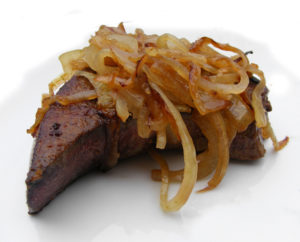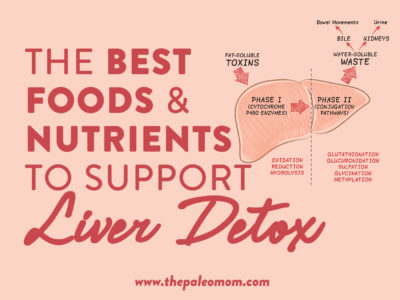In Part 1 of this series, I summarized the phases of liver detoxification and addressed the misconception of liver as a “sponge” for toxins due to its role in processing harmful substances. But, this is just the beginning of the discussion! Given all the hard, nutrient-consuming work the liver does, what should we eat to keep it functioning optimally? What vitamins and minerals help support detoxification? And is there any validity to liver detox diets, supplements and programs?
Key Nutrients for Detoxification
Each phase of detoxification relies on different nutrients, and inadequate intake of those nutrients can spell trouble for the body’s ability to neutralize and excrete toxins. In fact, nutrient deficiency can make toxins even more dangerous by resulting in incomplete chemical transformation or prolonged circulation in our blood. So, to support all components of liver detoxification, it’s important to eat a nutritionally dense diet with the following stand-outs!
Phase I Nutrients
Phase I requires a wide variety of nutrients for the cytochrome p450 enzymes to do their job. For starters, a too-low protein intake can lower the activity of these enzymes, so it’s a good idea to consume sources of high-quality protein (particularly from animal products like seafood, chicken, beef, and eggs). Beyond that, the following vitamins and minerals are needed for proper functioning of the various Phase I enzymes, and to ensure toxins are processed quickly enough to avoid damaging our bodies:
- Magnesium, found in dark leafy greens, nuts, seeds, legumes, avocados, bananas, cocoa, and seafood.
- Vitamin A (retinol), found in liver, eggs, and dairy foods.
- Vitamin B2 (riboflavin), found in liver, beef, clams, portabella mushrooms, almonds, dairy, salmon, and eggs.
- Vitamin B3 (niacin), found in tuna, poultry, salmon, lamb, beef, sardines, shrimp, asparagus, tomatoes, dark leafy greens, and avocados.
- Vitamin B5 (pantothenic acid), found in brewer’s yeast, cauliflower, kale, egg yolks, broccoli, tomatoes, organ meat, poultry, sweet potatoes, avocado, and salmon.
- Vitamin B6, found in fish, liver and other organ meats, potatoes, sweet potatoes, sunflower seeds, spinach, and bananas.
- Vitamin B12, found in organ meats (especially liver), shellfish (especially clams), and other animal products like meat, poultry, eggs, and dairy.
- Folate, found in dark leafy greens (like spinach, bok choy, turnip greens, parsley, and lettuce), broccoli, legumes, cauliflower, asparagus, and beets.
On top of those, since Phase I relies heavily on oxidation to help transform toxins, free radicals are produced—making it imperative that the liver has plenty of antioxidants to draw from! In particular, the most important antioxidants for the liver are:
- Vitamin C, found in citrus fruits, cantaloupe, mango, papaya, bell peppers, berries, and pineapple (along with many other fruits and vegetables).
- Vitamin E, found in nuts and seeds (especially sunflower seeds and almonds), avocado, beet greens, spinach, collard greens, and some seafood like swordfish.
- Beta-carotene, found in carrots, sweet potatoes, leafy greens, broccoli, squash, tomatoes, and most other fruits and vegetables with an orange, yellow, or green color.
- Zinc, found in oysters, crab, lobster, beef and poultry, pumpkin seeds, cashews, almonds, and legumes.
- Selenium, found in Brazil nuts, organ meats, mushrooms, seeds (such as sunflower, sesame, and flax), broccoli, cabbage, spinach, seafood (especially tuna, salmon, halibut, sardines, and shrimp), ham, beef, and chicken.
Phase I activity can get particularly ramped up from a high intake of alcohol, cigarettes, drugs, or caffeine, as well as a high absorption of enterotoxins due to compromised gut health. So, both antioxidant and cofactor (those vitamins and minerals needed for cytochrome p450 enzymes to do their job) requirements increase when these substances are ingested in large quantities or with high frequency!
Phase II Nutrients
Since Phase II involves attaching new molecules to toxins, the raw building blocks for those molecules are a dietary must-have. If they’re in short supply, the liver can’t adequately neutralize toxins and make them water-soluble enough to excrete! The most important players here are certain amino acids and sulfur, including:
- Glycine (to complete glycination), found in gelatin and bone broth, connective tissue attached to bones and meat, pork feet/skin/ears, pastrami, organ meats, crustaceans, and poultry.
- Glutamine, found in beef, pork, chicken, seafood, organ meats, spinach, and parsley. (Because glutamine is heat-sensitive, the most bioavailable sources are raw—such as sushi and raw spinach.)
- Cysteine (which contains sulfur), found in beef, chicken, seafood, pork, eggs, dairy, red peppers, garlic, broccoli, Brussels sprouts, and onions.
- Methionine (which contains sulfur), found in most animal-based foods (especially meat and eggs, but also fish and eggs), as well as Brazil nuts.
- Taurine (which contains sulfur), found in meat, fish and shellfish, eggs, and dairy.
 If Phase I activity is high (and oxidation is rampant as a result), the liver’s supply of glutathione gets used up to help neutralize free radicals. And, that can leave Phase II without enough glutathione to complete its glutathionation pathway! That makes it really important to get enough glutathione-building foods in our diet to support optimal liver function. Those are foods high in the sulfur-containing amino acids cysteine, methionine, and taurine.
If Phase I activity is high (and oxidation is rampant as a result), the liver’s supply of glutathione gets used up to help neutralize free radicals. And, that can leave Phase II without enough glutathione to complete its glutathionation pathway! That makes it really important to get enough glutathione-building foods in our diet to support optimal liver function. Those are foods high in the sulfur-containing amino acids cysteine, methionine, and taurine.
Along with the building blocks for conjugation molecules, Phase II can be supported with other nutrients also used during Phase I (particularly certain B vitamins, vitamin C, and selenium).

For A Healthy Liver, Eat… Liver!
 It’s no secret I’m a huge fan of organ meats (especially liver!), and it just so happens that eating liver is one of the best ways to promote the health of our own livers. Lucky for us, this organ meat is jam-packed with vitamin A, zinc, B vitamins (riboflavin, niacin, vitamin B6, folate, vitamin B12, and pantothenic acid), glycine, methionine, cysteine, and glutamic acid… all of which support the various oxidation, reduction, hydrolysis, and conjugation pathways involved in detox. How convenient is that? If you’re disgusted by the idea of eating liver, don’t worry. Organic 3 Beef Liver Capsules are conveniently packaged within a gelatin capsule–you get all the same nutrients as fresh liver, with zero taste or hassle!
It’s no secret I’m a huge fan of organ meats (especially liver!), and it just so happens that eating liver is one of the best ways to promote the health of our own livers. Lucky for us, this organ meat is jam-packed with vitamin A, zinc, B vitamins (riboflavin, niacin, vitamin B6, folate, vitamin B12, and pantothenic acid), glycine, methionine, cysteine, and glutamic acid… all of which support the various oxidation, reduction, hydrolysis, and conjugation pathways involved in detox. How convenient is that? If you’re disgusted by the idea of eating liver, don’t worry. Organic 3 Beef Liver Capsules are conveniently packaged within a gelatin capsule–you get all the same nutrients as fresh liver, with zero taste or hassle!
Nutrivore Weekly Serving Matrix
An easy-to-use and flexible weekly checklist
to help you maximize nutrient-density.
The Weekly Serving Matrix is very helpful! I’ve been eating along these lines but this really helps me know where to focus vs. which foods serve a more secondary role. It’s super helpful and has taken a lot of worry out of my meal planning. Thanks!
Jan
You probably also noticed vegetables, especially dark leafy greens and cruciferous vegetables, and seafood mentioned many times. And, there we have the trifecta: the most nutrient-dense diet is one whose base is organ meat, tons of veggies, and seafood, rounded out with other quality meats, fruit, eggs, nuts and seeds. Yes, that’s Paleo, but it’s what I qualify as nutrient-dense Paleo, meaning there’s an additional focus on the most nutrient-packed foods even within the Paleo template.
And as for detox programs, I recommend reading labels carefully. Liver detoxification simulators like milk thistle increase demand for nutrients. If either a clean, thorough supplementation approach or focus on all the aforementioned foods isn’t part of the program, then it’s most likely a waste of money and time.
What If It’s Not Organic?
Many people are afraid of eating liver because they can’t obtain it from grass-fed, organic, free-range animals. In this case, conventional liver is still better than no liver! Because a little liver goes a long way (in terms of nutrition), and because (as we discussed in Part 1!) the liver isn’t actually hoarding more toxins than other parts of the body, the nutritional benefits of conventional liver still outweigh any potential downsides, as far as our health goes.
So, enjoy a nice helping of liver, and aim for a diverse diet rich in both nutrient-dense plant and animal foods, and get a steady supply of sulfur-containing amino acids. Your detoxification pathways will thank you!











